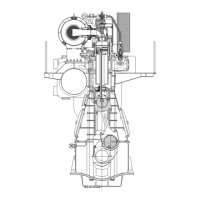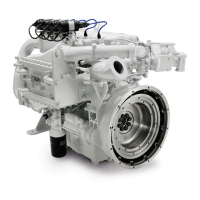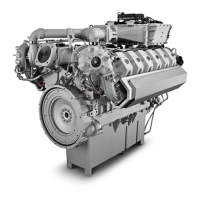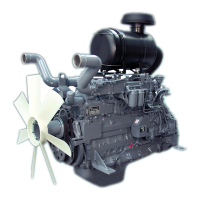MAN B&W 17.03
Page of 2
MAN Diesel
MAN B&W MC/MC-C/ME/ME-B/MEC/MEGI engines 198 42 221.4
178 57 45-6.0
Fig. 17.03.01: MAN Diesel 1st or 2nd order electrically driven moment compensator, separately mounted,
option: 4 31 605.
Electric Driven Moment Compensator
If it is decided not to use chain driven moment
compensators and, furthermore, not to prepare
the main engine for compensators to be tted
later, another solution can be used, if annoying
vibrations should occur: An electrically driven
moment compensator synchronised to the cor-
rect phase relative to the external force or mo-
ment can neutralise the excitation.
This type of compensator needs an extra seating
tted, preferably, in the steering gear room where
vibratory deections are largest and the effect of
the compensator will therefore be greatest.
The electrically driven compensator will not give
rise to distorting stresses in the hull, but it is more
expensive than the engine-mounted compensa-
tors. It does, however, offer several advantages
over the engine mounted solutions:
• When placed in the steering gear room, the
compensator is not as sensitive to the position-
ing of the node as the compensators 2) and 3)
mentioned in Section 7.02.
• The decision whether or not to install compen-
sators can be taken at a much later stage of a
project, since no special version of the engine
structure has to be ordered for the installation.
• No preparation for a later installation nor an ex-
tra chain drive for the compensator on the fore
end of the engine is required. This saves the
cost of such preparation, often left unused.
• Compensators could be retrot, even on ships
in service, and also be applied to engines with a
higher number of cylinders than is normally con-
sidered relevant, if found necessary.
• The compensator only needs to be active at
speeds critical for the hull girder vibration. Thus,
it may be activated or deactivated at specied
speeds automatically or manually.
• Combinations with and without moment com-
pensators are not required in torsional and axial
vibration calculations, since the electrically
driven moment compensator is not part of the
mass-elastic system of the crankshaft.
Furthermore, by using the compensator as a vi-
bration exciter a ship’s vibration pattern can easily
be identied without having the engine running,
e.g. on newbuildings at an advanced stage of
construction. If it is veried that a ship does not
need the compensator, it can be removed and re-
used on another ship.
It is a condition for the application of the rotating
force moment compensator that no annoying lon-
gitudinal hull girder vibration modes are excited.
Based on our present knowledge, and conrmed
by actual vibration measurements onboard a ship,
we do not expect such problems.
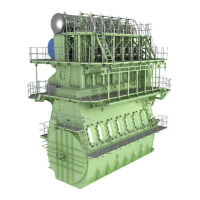
